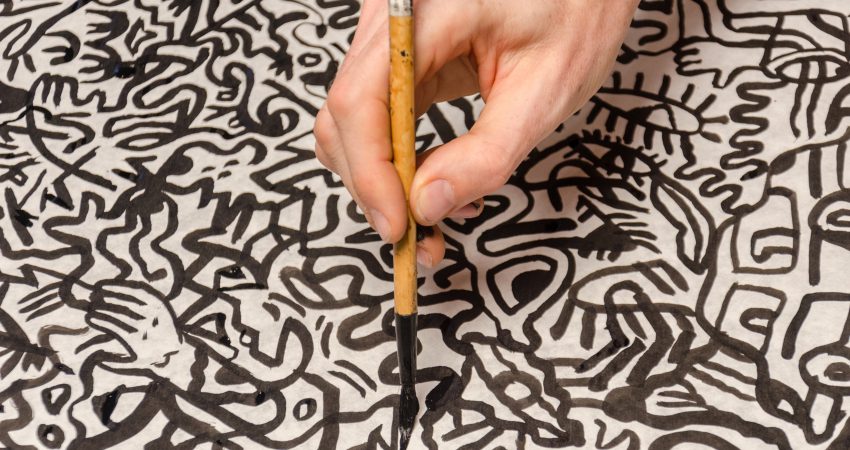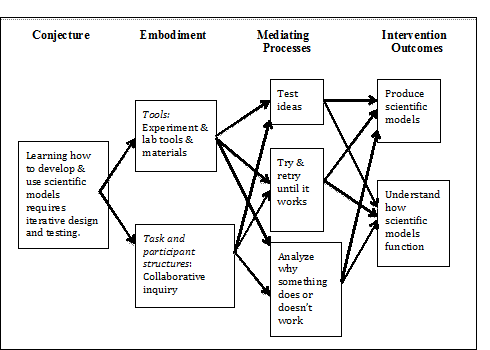
By Jean J. Ryoo - September 2014
PAPER CITATION
Sandoval, W. (2014). Conjecture mapping: An approach to systematic educational design research. Journal of the Learning Sciences, 23, 18–36. doi:10.1080/10508406.2013.778204
Theoretical Basis
Design-based research (DBR) is a methodology for testing educational theories while creating and improving educational interventions, environments, and practices. This is done through iterative development and analysis of an educational design with implementation in educational settings. Critiques of DBR emphasize that this methodology lacks clear standards and cannot simultaneously build theory while improving program design. In this article, Sandoval proposes use of conjecture mapping in response to such critiques.
Conjecture mapping is an iterative technique for making the goals and theories that guide the design of a learning environment more explicit so that they can be empirically tested and refined. A conjecture map is a working document for specifying design relationships and research goals. By making conjecture maps of theoretical assumptions guiding program design, people can identify exactly what they want to test in their research process.
Sandoval shows that conjecture mapping has an “argumentative grammar”: a specific logic that guides how the method is used and how data are analyzed. He argues that the process of conjecture mapping disciplines researchers and practitioners to be specific and concrete about the theories and principles guiding their program design. This specificity allows the research-practitioner team not only to home in on the most important design problems to be solved, but also to continuously refine the research questions, theories, and principles that affect these design problems over time.
The example below demonstrates how conjecture maps work. This conjecture map illustrates the conjecture that students must experience iterative design and testing of scientific models in order to learn how to develop and use them.

To facilitate this learning, the research team designs the learning environment with specific tools and materials, task structures, participant structures, and discussion practices called embodiments. By embodiments, Sandoval means that the instructional ideas take a physical or material form—such as a lab activity or a classroom reflection. In this case, it is conjectured that giving students experiment and lab tools as well as opportunities for collaborative inquiry helps them learn how to design and use scientific models.
However, simply providing these tools or structures doesn’t lead to learning: Specific activities or mediating processes using the tools and structures must be facilitated. One way to understand mediating processes is through the observable interactions occurring between participants and the designed environment. A second way to understand mediating processes is by analyzing artifacts that participants produce in activities that may reflect the extent to which learners engage in activities or the kind of thinking that is considered important in the learning environment. In this example, the designers believe that providing opportunities for students to test their ideas, try and retry their models until they work, and analyze why these models do or do not function can support the learning goal. These mediating processes show how students engage with the embodiments.
According to this conjecture, the end result or outcome should be that students produce models and understand how they function toward making sense of scientific concepts and phenomena.
By creating conjecture maps at the start of a research project, researchers and practitioners can surface their assumptions and theories about how learning occurs while creating a framework for organizing their empirical research plan (for example, formulating research questions and deciding what key data to collect). The conjecture maps can then be continuously edited to reflect changes in assumptions and theories as data are collected and analyzed and as the research yields new ideas. The arrows in the example conjecture map represent the assumptions, ideas, and theories that are open to scrutiny through research.
Implications for Practice
DBR can prove useful for informal education practitioners and researchers who are interested in designing innovative educational interventions and understanding how those interventions support learning. When implementing DBR, informal science educators can use conjecture mapping to surface the ideas and theories that guide their activity, curriculum, or program designs. They then can better assess what features of their work are directly affecting learning or teaching practice. Conjecture mapping is useful in research-practice partnerships geared toward discussion of factors that go into designing and evaluating learning, teaching practice, or programs. This tool may also provide space for people in various roles to better support the improvement of programs by discussing their assumptions about how learning and teaching happen.
Suggestions for Further Reading
Design-Based Research Collective. (2003). Design-based research: An emerging paradigm for educational inquiry. Educational Researcher, 32(5), 5-8.
Penuel, W. R. & Fishman, B. J. (2012). Large-scale science education intervention research we can use. Journal of Research in Science Teaching, 49(3), 281–304.
Shavelson, R. J., Phillips, D. C., Towne, L., & Feuer, M. J. (2003). On the science of educational design studies. Educational Researcher, 32(1), 25–28.




